Owner and winemaker of his family estate in Bandol: “I was regarded as the ‘son of’ for a very long time”.
The 22nd interview in Le Figaro Vin’s series finds us once more in Provence, at Château de Pibarnon, a southern jewel which has been raising the profile of the Bandol wine region for nearly half a century. We are here to meet Éric de Saint-Victor, #29, a second-generation owner who, after many years in the shadow of his parents, has firmly established his place at the zenith of the appellation.
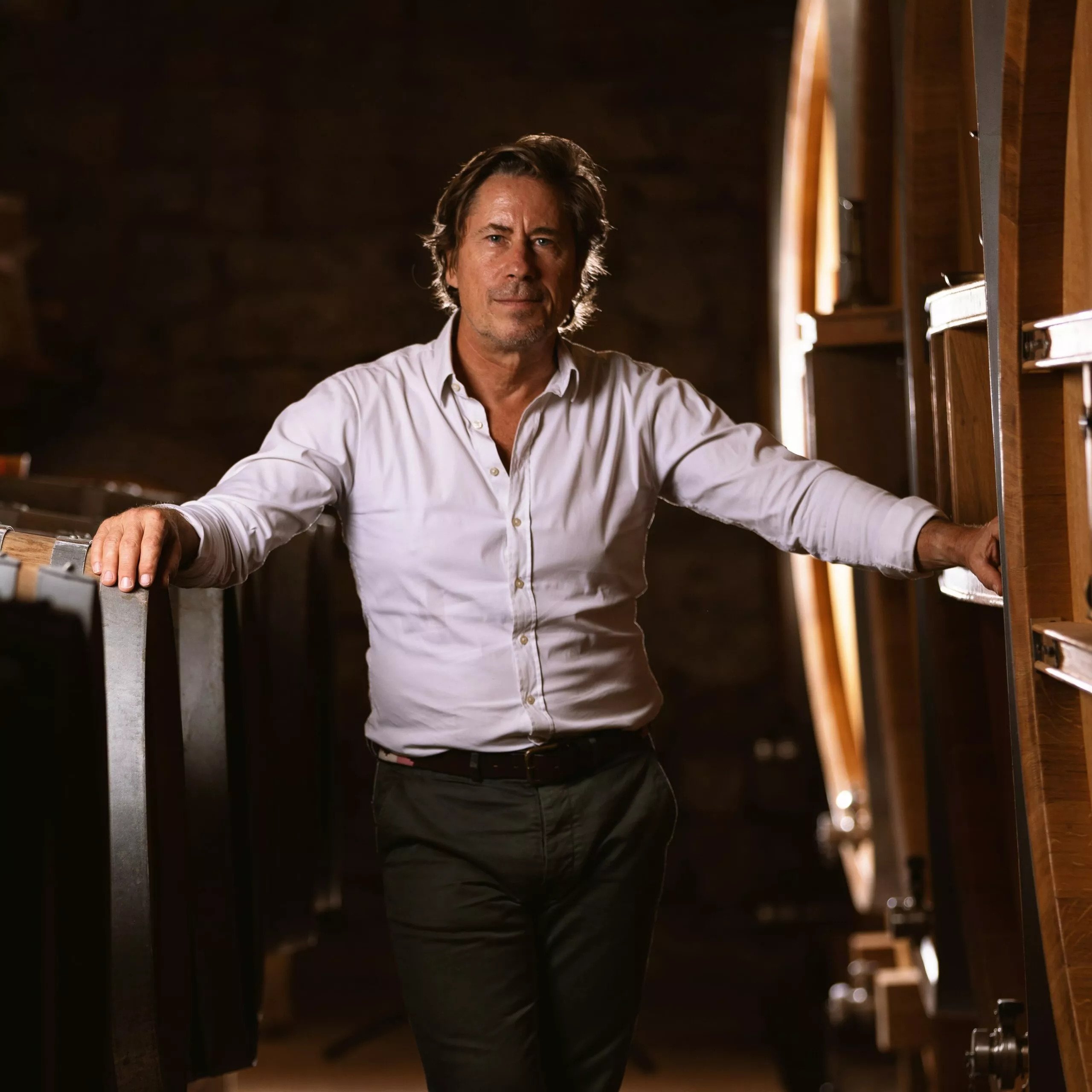
With a mere three hectares acquired in 1977, in an appellation which formerly struggled to get on the map, Château de Pibarnon began life as a genuine gamble. “My parents purchased what was within their means,” acknowledges Éric de Saint-Victor. “My father saw that you could do something extraordinary in Bandol. They created everything from scratch.” With its two red wines, two rosés, and one white, the estate now ranks among the most sought-after in France and plays a major part in the growing reputation of the Bandol wine region on both national and international stages.
Le Figaro Vin: How does it feel to be crowned a winemaking champion?
Éric de Saint-Victor: It reminds me of something my father used to say when he heard himself described as the best: “I am one of the two best, but we don’t know who the other one is!” We should bear in mind that in the 1980s and 1990s there was a competitive atmosphere between the estates, who were in a race to get results and win attention. A great wine had to be powerful and intense. That was the norm, especially in Bandol. When it comes to me, I am really fortunate to have had the time to develop my expertise and to benefit from well-established vines, so today, above all, the challenge is with myself, in the pursuit of craftsmanship rather than competition. It makes me very happy to be regarded as a champion, but just like with sailing, you have to put your own boat in order before taking on others.
Have you been training for long?
At the outset I learnt alongside my parents. My father taught me about winemaking, my mother about the business side of things. The training never stops, and you are always taking risks.
Who is your mentor?
Alain Brumont (of Château Montus and Château Bouscassé in the Southwest, ed.) who visited the estate in 1989. He was the first winemaker of note to treat me as an equal. I was regarded as the “son of” for a very long time, whereas he spoke to me as one winemaker to another, which boosted my confidence. I think that more than having a mentor, what is really valuable is to analyse the pathways taken by winemakers whose wines you love and to see how these can be understood through their wines. In this respect tasting is key to analysis. I always say that Pibarnon’s first customer is me!
Is wine a team sport?
Of course. We have a talented team here and the working atmosphere is pivotal. I don’t want a team of pruning shears; I want human beings. Everyone brings something to the table, and I favour consensus and collective decision-making.
What is the key to making a good wine? The terroir or the winemaker?
We are merely part of the terroir, it is our job to give it meaning, to interpret it, whereas the substrate is immutable.
To what do you owe your success?
First and foremost to the terroir. Here in Bandol we have a unique geological layer, a Triassic limestone soil which is exceptional, enjoys excellent hydromorphology, and produces grapes with quite intense tannins.
Is your family proud of you?
I think so, even though I have been an “orphan” since the ages of 49 and 50.
Your favourite colour?
I like white, although it’s hard to choose. I roll with the seasons. My favourite style of wine is the one that takes me into its own world. I don’t look to be amazed, I go for depth and the experience of discovery.
Your favourite grape variety?
Mourvèdre, which has a fascinating, very romantic character. It’s a Don Quixote, untamed and freethinking. It’s a grape variety that requires freedom, it’s not a circus animal: you can’t put it in a box, you have to know how to guide it.
Your favourite wine?
Because of my genes it has to be Le Rouge du Château, which is Pibarnon’s standard bearer, combining all the attributes of the estate. In our southernmost environment we contrive to produce something fresh, which makes for an astonishing paradox on the palate. These are wines of light rather than wines of heat.
Your favourite vintage?
No vintage is exactly like another. I really liked 2019, for which we went out on a limb.
If your wine was a person, who would it be?
A character from fiction, but intellectually rich, a bit like Steve McQueen with a feline side. It’s a wine that sometimes shows its claws but has a smooth and solitary side.
What are the best circumstances in which to taste your wine?
When the wines are young, over a meal, when they have aged, in a more contemplative way, especially after 25 years of ageing. The latter are more meditative wines, producing more heightened states of intoxication, whereas the former make the conversation flow.
Who is your strongest competition?
Drought.
What is your greatest trophy?
My father won six gold medals at the Concours Général Agricole de Paris. He exuded a special charm and had built up some very strong relationships with sommeliers and winemakers. In 1993 I began to take over responsibility for winemaking, then, a few years after that, I entered a competition in England. I gave that a shot because in France I would have been afraid of only getting bronze! Neither Bandol wines nor Mourvèdre were specified on the entry form, so I competed in the “others” category and six weeks later I was awarded a prize. This story aside, the greatest trophy for me today is to share a tasting with a great sommelier and to see in his eyes a growing understanding which reveals a sense of experiencing something new.
Who would be your ideal successor on the podium?
Someone who could take my place while showing true independence through their own take on things. Someone who could build on their experience on the estate and find their own voice: they would be the ideal successor.
Winemaker of this revered estate in Pommard: “I’m a bit of a junkyard dog!”.
The 21st interview in Le Figaro Vin’s series finds us on our third visit to Burgundy to meet Paul Zinetti, #30. Burgundian by birth, he joined Domaine du Comte Armand, among the most iconic Côte-d’Or estates, in 2010, and took over the winemaking reins from Benjamin Leroux in 2014. Today he cultivates nine hectares of vines in Pommard, where the estate is based, together with vineyard plots in Volnay and Auxey-Duresses.
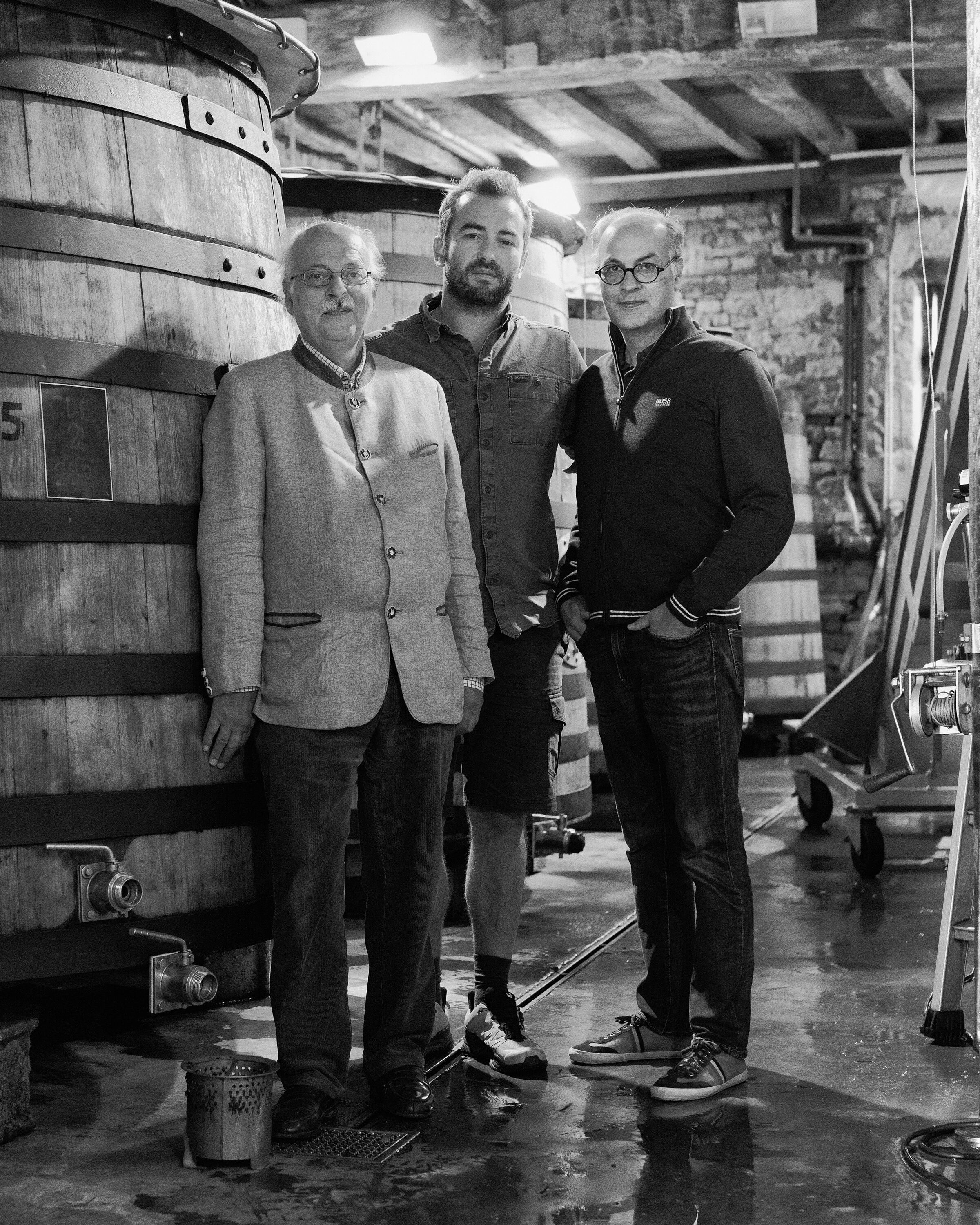
Paul Zinetti is forthright and unconcerned with social niceties. As a manager who is not an owner – a rarity in Burgundy – he laughingly admits to his lack of formal qualifications, being neither an oenologist nor even the holder of a technical diploma. “I’m a bit of a junkyard dog!”, declares the forty-year-old in a deliberately provocative manner. Yet, you can feel his extraordinary sensitivity, his capacity to observe and interpret a terroir whose nature changes with the passing years, which allows him to produce wines of exceptional finesse from every vintage.
Le Figaro Vin: How does it feel to be crowned a winemaking champion?
Paul Zinetti: It makes me happy, but I will be humble about it as I have never set much store by awards.
Have you been training for long?
Since I was 18. I spent five years in Languedoc, then I came back up to Mâconnais, before landing in Côte-d’Or.
Who is your mentor?
Dominique Lafon, in Mersault, and his brother Bruno in Languedoc. I have built up my know-how by learning from a number of winemakers, but those are the two who have really inspired me.
Is wine a team sport?
Yes, I’m a bit like the captain of the ship, and my team follows me.
What is the key to making a good wine? The terroir or the winemaker?
Both of them. I depend on the terroir, but I try to give it the best possible interpretation through my wines. Terroir and winemaker must go hand in hand. Great terroirs give you an advantage, but you have to know how to handle them, how to tame them. You will never be able to make great wines from poor terroir, although I appreciate that global warming means you can make good wines pretty much everywhere.
To what do you owe your success?
To myself.
Is your family proud of you?
A little bit, I think. They are happy rather than proud. These are things that remain unspoken.
Your favourite colour?
Red for wine, otherwise green.
Your favourite grape variety?
Pinot Noir, which is sensitive and refined.
Your favourite wine?
Le Grand Rouge from Revelette, for sentimental reasons.
Your favourite vintage?
2015, which I believe will turn out to be a great vintage.
If your wine was a person, who would it be?
It would be a Scorpio, which is my astrological sign. With my wines it’s a case of “all or nothing”, as they say. They are full-on wines.
What are the best circumstances in which to taste your wine?
Among friends.
Have you ever thought about chemically enhancing yourself, or your wine?
Personally never, but I did adulterate my wine when I was young. That said, red wine is an excellent stimulant. We should remember that they used to drink red wine on the Tour de France back in the 1920s.
Who is your strongest competition?
Myself, first and foremost.
Which competition do you dread the most?
The seasons of pruning and harvesting, namely spring and summer.
What is your greatest trophy?
My children.
What has been your most innovative strategy in the vineyard and in the cellar?
Constant observation and questioning everything. What was true five years ago is by no means necessarily true today.
Who would be your ideal successor on the podium?
Raphaële Tinoco, a young woman already on our estate team, who I hope will take over one day.
Co-owner and winemaker of Château Beauséjour Duffau-Lagarrosse: “I do not believe that the land belongs to us”.
The 20th interview in Le Figaro Vin’s series takes us back to Bordeaux, where Joséphine Duffau-Lagarrosse, #31, maintains her family legacy at Château Beauséjour, Premier Grand Cru Classé B de Saint-Émilion. With her impressive maturity and depth of insight, she ranks among the most talented winemakers of her generation.
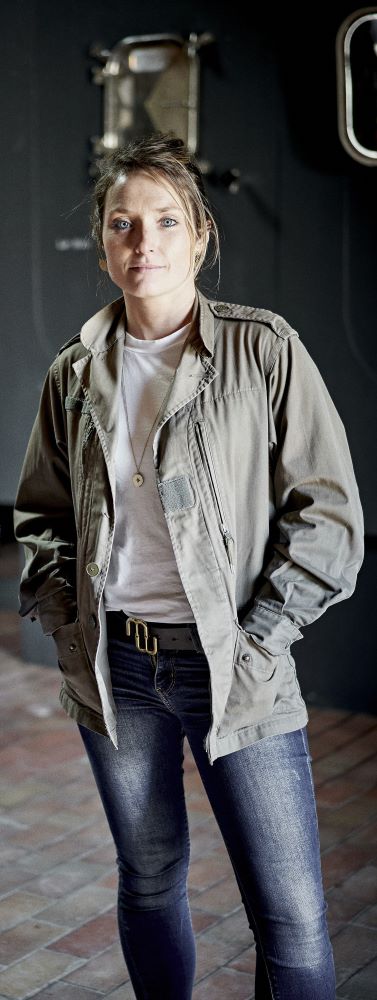
Her seven-hectare estate, in the iconic Right Bank appellation of Saint-Émilion, boasts an exceptional limestone plateau terroir. The vineyard is planted with rows of Merlot and of Cabernet Franc, which produce wines of extraordinary vivacity.
Having been passed down the generations since 1847, Château Beauséjour underwent a tumultuous sale in 2021. It now belongs jointly to Joséphine Duffau-Lagarrosse, 33 – the last of the family remaining at the Château – and Prisca Courtin, 35, granddaughter of Jacques Courtin, founder of Clarins. Joséphine draws to good effect on her ten years’ experience on estates ranging from Burgundy to Mexico, by way of New Zealand, and finally to Bordeaux, notably with Bernard Magrez. Today she oversees the production of her estate’s wines with great panache, supported by two renowned consultant oenologists, Axel Marchal and Julien Viaud.
Le Figaro Vin: How does it feel to be crowned a winemaking champion?
Joséphine Duffau-Lagarrosse: If that is how you regard me, then I feel a degree of pride!
Have you been training for long?
Yes, for quite some time. My grandparents on both sides were great wine connoisseurs. They were a formative influence from my earliest years and had me tasting well before I came of age. I have deep aromatic memories that underpin my keen sense of smell and taste. My nose has been practising for a long time. As far as vinification is concerned, there is only one vintage per year, and each one is different. We always tell ourselves that we will do things differently next time. So every year involves further training.
Who is your mentor?
Axel Marchal and Julien Viaud (who embody the new generation of consultant-oenologists in Bordeaux, ed.) are part of my team. They challenge me but their job is not, strictly speaking, to mentor me. I would suggest, rather, that nature is our mentor. From one year to the next, we have to aim higher.
Is wine a team sport?
Yes, very clearly, because wine starts with the vines, and I am not on my own in the vineyard. Some members of my team have been at Beauséjour for 30 years, and without them – Izilda and Christophe – it would be difficult. They bring their own insights and their deep familiarity with the property. To give some context, Izilda’s parents were originally hired by my great-grandparents. As for the vinification, I have Axel Marchal, Julien Viaud, and Camille de Villenaut to support me. We challenge each other and move forward as a team!
What is the key to making a good wine? The terroir or the winemaker?
That’s a really tricky question. When you have a great terroir, if the winemaker makes a mistake, in terms, it is the terroir that can rectify the situation. On the other hand, a good winemaker might make something fantastic from a poor terroir. But, if I have to decide, the terroir comes out on top.
To what do you owe your success?
It’s partly a question of upbringing, which I owe to my family. They taught me the value of the land and of hard work. As for the success of Beauséjour, that is down to meeting Prisca (Courtin, President of the Clarins Group’s Oversight Committee, ed.) who believed in our project. My upbringing has enabled me to follow through on our acquisition, and to persevere in the face of stressful conditions.
Are your parents proud of you? And is your dog?
Yes, I think so. My dog Tokaj is too, and happy to spend every day here at Beauséjour.
Who is your biggest supporter?
Prisca Courtin.
Your favourite colour?
Blue.
Your favourite grape variety?
Cabernet Franc.
Your favourite wine?
I love Domaine de Vaccelli’s Granit. It is the wine which, in a blind tasting, I always place in Burgundy, even though it’s from Corsica!
Your favourite vintage?
1990 (the Beauséjour vintage which has acquired legendary status and the year that Joséphine was born, ed.).
If your wine was a person, who would it be?
Someone with quiet strength who opens up over time.
What are the best circumstances in which to taste your wine?
Over a good meal, with a delicious piece of meat, and with friends.
Have you ever thought about chemically enhancing yourself, or your wine?
Never.
For what price would you be prepared to sell your estate?
I do not believe that the land belongs to us. My grandfather used to say – and my father would repeat it – men pass through while the terroir remains. I cannot sell what isn’t mine. So I will never sell, not for any price.
Who is your strongest competition in Saint-Émilion?
That’s rather a loaded question. We are often told that we are the next Ausone. In terms of terroir, I believe that to be true.
Which competition do you dread the most?
I don’t feel as though we are in a competition with our neighbours. If all the Saint-Émilion Grands Crus perform, that has an international reach. I don’t have the competitive streak. Contrary to what people might think, we do not compete with each other in Saint-Émilion, we compete for our appellation’s international ranking. I check out the ratings of my neighbours’ wines, of course, but you have to behave in the right way. If our neighbours, like Bécot, Canon, Angélus etc., were to come to us tomorrow asking to borrow some equipment, then of course we would help them out.
What are you most proud of?
The revival of Beauséjour.
What has been your most innovative strategy in the vineyard and in the cellar?
There have been technical innovations, of course, but I feel there has been a return to common sense. My most innovative strategy has been to refocus on observation and intuition. We have gone through a phase which has brought in a mass of technology, like measuring probes, and infrared. We have also learnt that innovation is not the answer to everything. We need to get back to the basics.
Who would be your ideal successor on the podium?
It would be someone with common sense, humility, and an open mind.
Cellar Master of Champagne’s oldest house: “I see myself as a craftsman”.
For the 19th interview in Le Figaro Vin’s series, we pay our third visit to Champagne to meet Frédéric Panaïotis, #32, chef de caves of Maison Ruinart for the past 16 years. He is now, beyond question, one of the most influential figures in Champagne, fashioning wines of outstanding precision and purity from every vintage.
Though always at home in the world of wine – his grandparents owned a small winery – his original ambition was to be a vet. However, a seminal encounter with a great Burgundy set him on a different path: after graduating in agronomy he became an oenologist, cutting his teeth in California before working for 12 years at Veuve Cliquot. He then joined Maison Ruinart in 2007, going on to become one of the most inspiring chefs de caves of his generation.
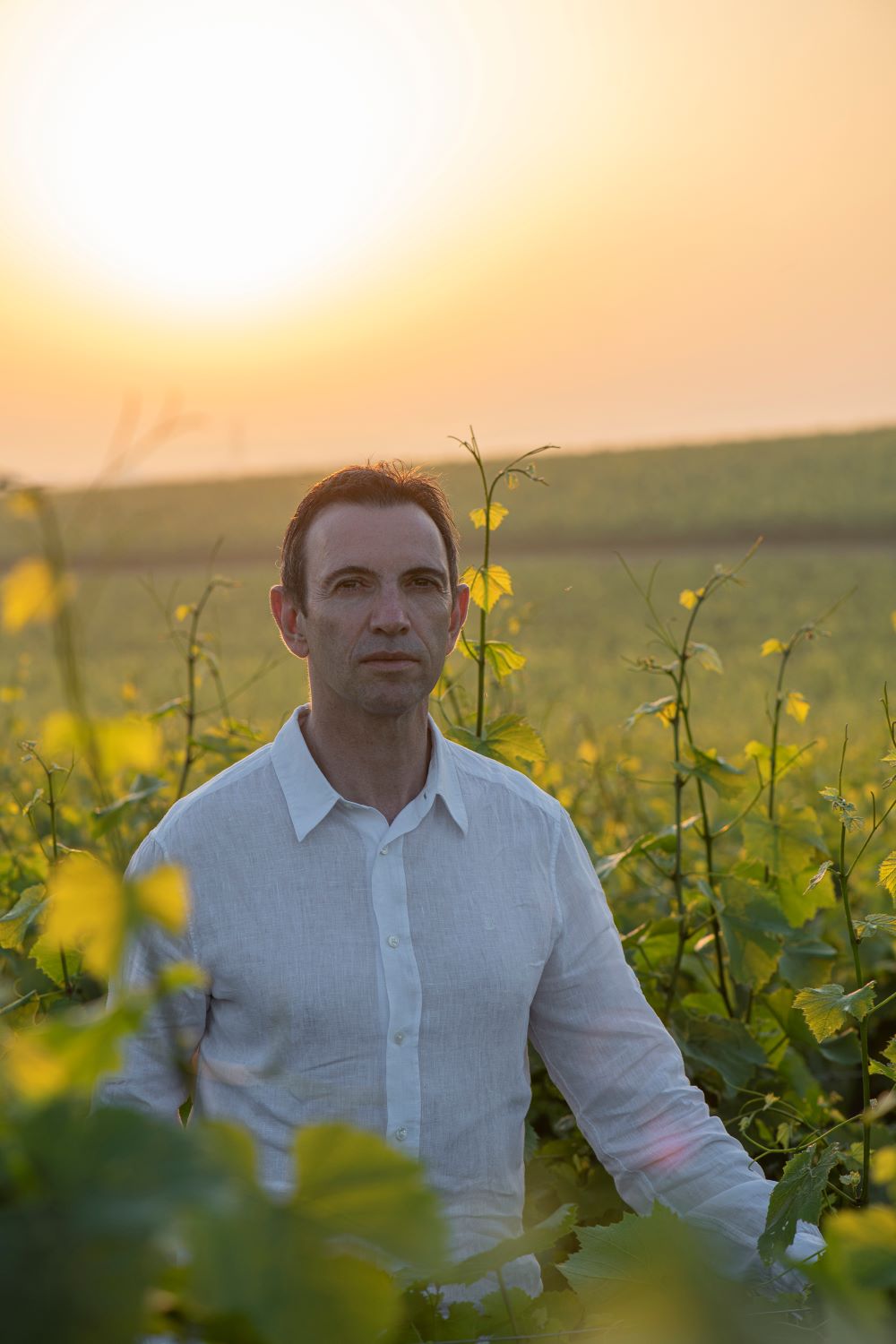
Le Figaro Vin: How does it feel to be crowned a winemaking champion?
Frédéric Panaïotis: That’s something to celebrate, isn’t it? It calls for champagne! And a Blanc de Blancs would be perfect. More seriously, my congratulations go, first of all, to the entire team that works alongside me.
Have you been training for long?
For 39 harvests (make that 40 including one in New Zealand in 2001!).
Who is your mentor?
I would say there are two of them: on the one hand the natural elements, especially the climate which sets the tempo, and on the other, Frédéric Dufour, President of Ruinart, who keeps challenging me and is always driving us forward.
Is wine a team sport?
Completely. Wine is always the product of the collective effort of talented men and women, from the vine all the way through to its development and its launch. And we really do have a mixed team at Ruinart, with genuine parity, specifically in our winemaking team.
What is the key to making a good wine? The terroir or the winemaker?
If your definition of terroir includes the selection of grape varieties and the way the vines are trained, in addition to the climatic elements and the soil – and that is how I see it – then the terroir is indisputably the foundation for making great wines.
To what do you owe your success?
To a combination of passion for the world of vines and wine, a lot of hard work, and also the good fortune to have been in the right place at the right time…but as the saying goes, “God helps those who help themselves!”.
Is your family proud of you?
I hope so! Whether on earth or in heaven…In any case, as far as my nearest and dearest are concerned, they appear to enjoy our wines. And naturally, that allows them a touch of pride.
Your favourite colour?
Sea blue.
Your favourite grape variety?
Chardonnay, of course!
Your favourite wine?
Dom Ruinart Blanc des Blancs.
Your favourite vintage?
2010, while awaiting 2019.
What are the best circumstances in which to taste your wine?
Always among friends, because I cannot imagine opening lovely bottles without sharing them. And sometimes it only needs two of you!
Have you ever thought about chemically enhancing yourself, or your wine?
To be honest, I’m more the sort of person to implement anti-doping controls. So the answer is no, never.
For what price would you be prepared to sell your estate?
Maison Ruinart doesn’t belong to me, and in any case, I don’t believe it’s for sale.
Who is your strongest competition?
Rather than a competition, I prefer to think of it as a rivalry among those who are, in many cases, good friends. This means we are always looking to improve, aspiring to excellence. Nothing beats rivalry for making you test your limits and give it your all!
Which competition do you dread the most?
The next harvest, because you never know what it will bring. And in the longer term, climate change, which will affect us more and more profoundly. We are going to have to get to grips with it and reinvent ourselves, which is what we have started to do with our new wine, Blanc Singulier.
What is your greatest trophy?
The title of Supreme World Champion, awarded by the CSWWC (Champagne and Sparkling Wine World Championship) in 2022 for Dom Ruinart Blanc de Blancs 2010, because it represents the culmination of a project begun by my predecessors in 1998, which involved trialling tirage under cork. I was lucky enough to inherit this project and see it to fruition.
But the best reward comes through conversations and shared moments with our customers when they have enjoyed tasting one of our champagnes.
What has been your most innovative strategy in the vineyard and in the cellar?
I see myself more as a craftsman than an artist or a researcher. So my strategy is to try to evaluate and understand in minute detail every step from the vine to the wine. The aim is to replicate, and where possible enhance, what we already do. I am not sure that is a very innovative strategy, but it does help us improve!
Who would be your ideal successor on the podium?
Ask me the same question in six years’ time, in 2029, when we celebrate the 300th anniversary of Maison Ruinart!
Owner and winemaker of his family estate in Jura: “Thirty years ago no one believed in Jura wines”.
The 18th in Le Figaro Vin’s series brings us to the Jura, a growing force as a wine region, to meet Jean-François Ganevat, #33, who ranks among the most successful and respected natural winemakers in France. He creates his exquisite wines, which are increasingly prized and hard to get hold of, at Domaine Ganevat, in the hills of Rotalier.
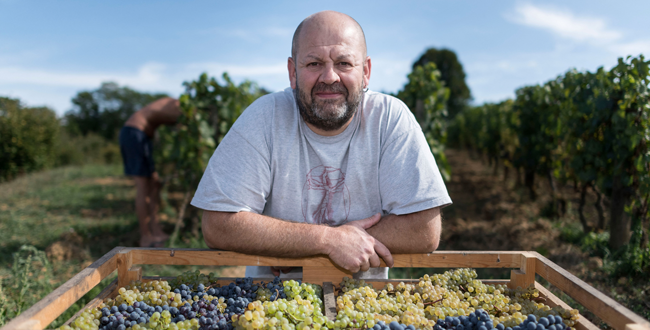
Le Figaro Vin: How does it feel to be crowned a winemaking champion?
Jean-François Ganevat: That is always great news. It makes me blush, because I don’t make wine to win medals, but I am delighted by all the excitement around natural wine and by the fact that real aficionados are happy to drink ours. Thirty years ago no one believed in Jura as a wine region, and the great majority of our wines were sold in Franche-Comté. Today we sell wine in 63 countries!
Have you been training for long?
For 14 generations. I have been immersed in it since I was a little boy, and I don’t know how to do anything else.
Who is your mentor?
I have mentored myself. We were introduced to Pierre Overnoy’s wines as children, but when we tasted them, we didn’t understand them. I still remember his visit to our school, and we thought his wines tasted revolting! It was quite some time before I got it, and it was my encounter with Didier Barral, in Languedoc, that really opened my eyes.
Is wine a team sport?
Of course, because to get good grapes you have to work the land, and you need manpower to do that. The term “organic” is meaningless if everything is mechanised. You need an authentic terroir, a philosophy, and a know-how to impart.
What is the key to making a good wine? The terroir or the winemaker?
It’s a combination of things, but a winemaker must know how to get the best from his terroir.
To what do you owe your success?
To my ancestors, because we are lucky enough to come from a family that has always pampered its vines.
Is your family proud of you?
I hope so. My father died in 2018, and he had already taken in how much progress we had made with the estate, in relation to the vines as well as the wines. He would have been proud today. There is no standard instruction manual for the winemaker’s profession, you learn something new every day. After 40 years I still don’t know what I will be doing tomorrow.
Your favourite colour?
I love the Jura reds. They have unbelievable drinkability and have really made a name for themselves.
Your favourite grape variety?
Savagnin for white wine and Poulsard for red.
Your favourite wine?
I really cannot answer that question because I am constantly being surprised.
Your favourite vintage?
2018, because the wines had real warmth, combined with high yields. Though when I tasted them as young wines, I found them thin and watery, with a sugary and not very aromatic aspect. A long period of maturation has produced an amazing patina and resonance.
If your wine was a person, who would it be?
The person who made it.
What are the best circumstances in which to taste your wine?
A wine should be tasted outside, and you should take your time over it. It should be drunk by people who are down-to-earth, because, as I always say, I want to make good wines, not grand wines.
Have you ever thought about chemically enhancing yourself, or your wine?
The more time goes by, the better you get to know your vines. I don’t need anything else. You have to learn how to discover your wine, and the wine learns to discover itself.
Who is your strongest competition?
Fear of frost, that’s what makes us sweat every year, because we no longer have proper winters.
Which competition do you dread the most?
The month of April.
What is your greatest trophy?
Recognition, from those who didn’t necessarily believe in me when I started out. However, from the beginning, I have been making the wines that I want to drink myself.
What has been your most innovative strategy in the vineyard and in the cellar?
Trust. I pamper my wines, and then the less I interfere with them the better things turn out.
Who would be your ideal successor on the podium?
I pass the little I know on to young colleagues who are just becoming established, who represent the future. A good wine is a complex of overlapping details. I would love to pass on my passion to my son, but he is only ten!
Owner of his family estate in Corsica and winemaker: “I was never any good as a conventional winemaker!”
The 17th interview in Le Figaro Vin’s series finds us in southern Corsica, where the luxuriant plots of Domaine Comte Abbatucci lie nestled in the heart of the Taravo Valley. We are here to meet Jean-Charles Abbatucci, #34, the island’s undisputed champion of biodynamic viticulture.
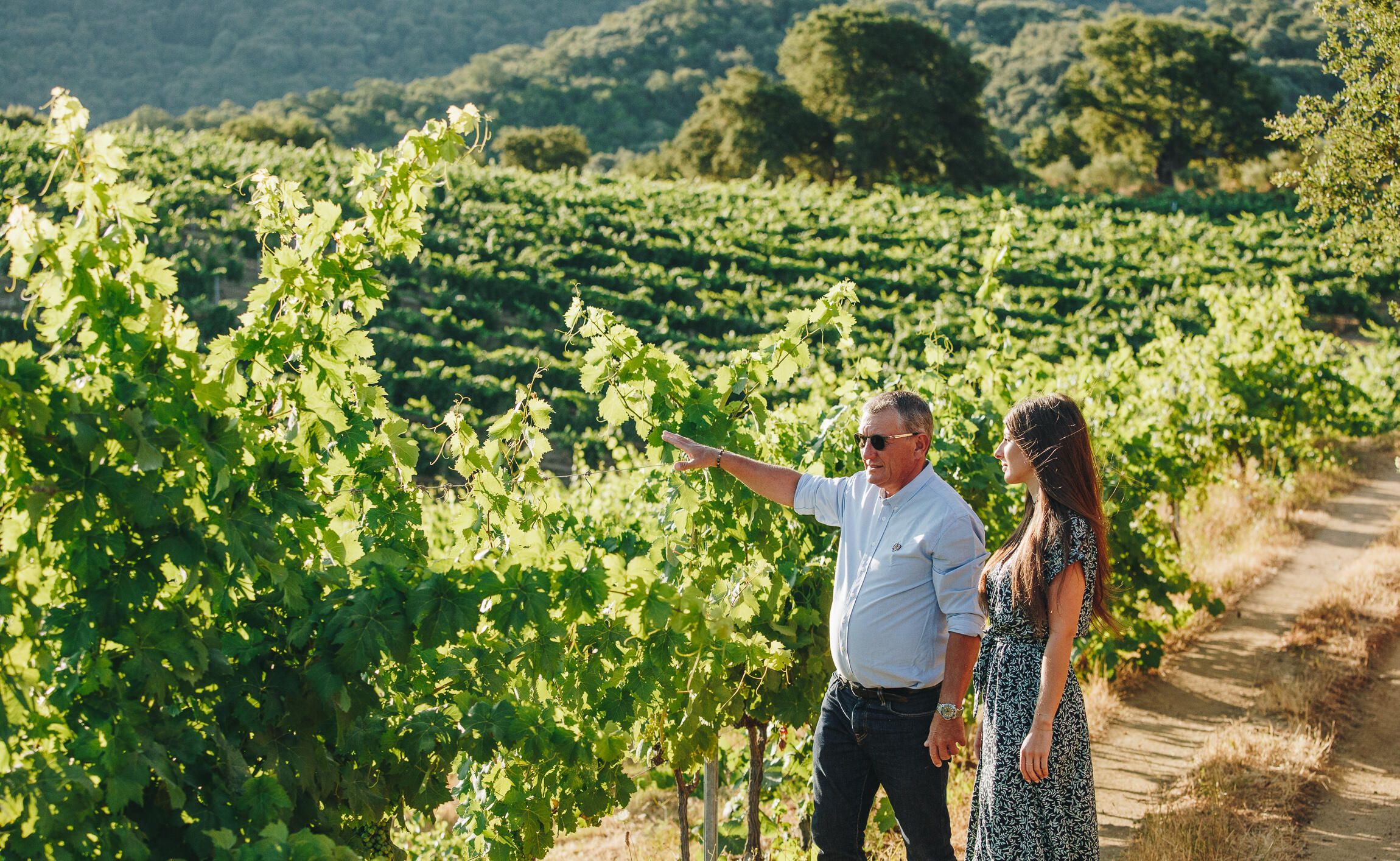
Domaine Comte Abbatucci is a living ampelographic museum of the Corsican wine region, with no fewer than 18 grape varieties grown alongside each other. With his hat firmly in place, and a pair of sunglasses hiding the twinkle in his eyes, the legendary winemaker that is Jean-Charles Abbatucci has acquired, over the course of many vintages, an encyclopaedic knowledge of all aspects of biodynamic viticulture. This knowledge extends from its history to its philosophy, with a dash of the esoteric.
While he describes himself as a pragmatist, he is constantly trying out new approaches, the most striking of which remains the treatment of vines with seawater. In the cellar, the wines range from those bearing the stamp of an outmoded nobility, from Ministre Impérial to Général de la Révolution, through to the cuvée named Faustine, after his daughter, available as a red, a white, and a rosé. Now a member of the Académie du vin de France, Jean-Charles Abbatucci embodies both the memory and the future of Corsican winegrowing.
Le Figaro Vin: How does it feel to be crowned a winemaking champion?
Jean-Charles Abbatucci: In my opinion being a champion is, above all, about giving expression to your terroir and to your grape varieties. It’s a particular vision of agriculture and the winemaker’s vocation.
Have you been training for long?
Yes, for 30 years now. When I started out, I was pretty conventional, doing what I could with the means at my disposal. But I was never any good as a conventional winemaker! One day, after ten years, something just clicked. This brought about my transition to organic and biodynamic agriculture, and the results of that transformation are what have made me a champion.
Who is your mentor?
From the 2000s onwards my mentor has been nature. When you take a step in her direction, she takes ten towards you. She can be capricious, admittedly, but then we are too. You have to be able to deal with that, assess the situation, and challenge yourself.
Is wine a team sport?
Yes, of course. The more you are a champion, the more you need a strong support team. Ultimately it is the athlete or the winemaker that lifts the trophy, but, behind the scenes, the winemaker benefits from the different perspectives that can be provided by an oenologist, a vineyard manager, etc.
What is the key to making a good wine? The terroir or the winemaker?
It is all of them together. I believe that there is an alchemy between the terroir, the winemaker, and nature.
To what do you owe your success?
In my case, to my father who was responsible for the preservation of the historic Corsican grape varieties. If he hadn’t been inspired to collect them, I wouldn’t be where I am today. But I must also acknowledge that I am fortunate to enjoy an exceptional terroir and a wonderful island.
Is your family proud of you?
Yes, they are all very proud. I have a very close working relationship with my brothers, one of whom is a restaurateur, the other a farmer. We are always bouncing ideas around.
Who is your biggest supporter?
It has to be nature, yet again. She gives me everything, not least the traditional Corsican grape varieties.
Your favourite colour?
Red.
Your favourite grape variety?
Sciaccerello. It’s a grape that provides unbelievable results when you know how to work with it, a kind of wild Pinot Noir, which displays finesse, elegance, and an aroma suggestive of myrtle and immortality. I also incline towards Carcajolo Nero, a variety that is highly characteristic of Corsica. I really struggle to choose between the two.
Your favourite wine?
For now, the one which truly stands the test of time remains Ministre Impérial, but the one which most fully expresses Carcajolo Nero would be my Cuvée Valle di Mare (vinified since 2019 and produced from vines treated with seawater, ed.).
Your favourite vintage?
2017 is a really lovely vintage. It was a temperate year which provided outstanding wines.
If your wine was a person, who would it be?
My wine personifies Corsica.
What are the best circumstances in which to taste your wine?
At any time, around a meal. It is a wine for epicures.
Have you ever thought about chemically enhancing yourself, or your wine?
No. I did it in my early days before I realised that it doesn’t work.
For what price would you be prepared to sell your estate?
It is priceless.
Who is your strongest competition?
The weather. You can lose a bit at every stage, and you can never get it back. In the end, you count your losses, and then you have to let them go. But if it’s my enemy, it’s also my life. It is an alchemy of both these things.
Which competition do you dread the most?
The two most critical months are May and June. That’s when we have to be on a war footing, especially when, like me, you work without a safety net.
What is your greatest trophy?
Being appointed to the Académie du vin de France, that is very special. It is in recognition of my work, but also for Corsica, as I am the first member from our island. That has taken some time, when you consider that Corsica has been a winegrowing region for over 3,000 years!
What has been your most innovative strategy in the vineyard and in the cellar?
Treating vines with seawater. That is what has made me stand out from the crowd. I think we will hear more and more about these wines. In my opinion, they belong among the new wines of the 21st century. A number of winemakers are becoming interested in the concept, but the precise principle and formula are mine.
Who would be your ideal successor on the podium?
My daughter Faustine, who will take over the estate.
Fifth-generation winemaker of this renowned family estate: “My first internship supervisor was Aubert de Villaine, of Domaine Romanée-Conti”
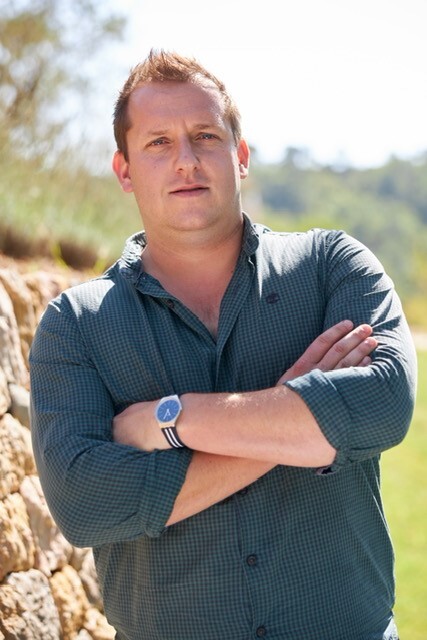
For the 16th interview in Le Figaro Vin’s series we head south down the Rhône Valley to one of its finest appellations, Châteauneuf du Pape, where we meet César Perrin, #35. Vintage after vintage he and his family devote themselves to their labours with total commitment.
An Eden in the Rhône Valley, surrounded by hills, vines, and olive trees, Château de Beaucastel is widely recognised as one of the most inspiring estates in Châteauneuf du Pape. While its origins date back to the 16th century, it was in the early 1900s that Pierre Perrin took it over. His son Jacques proved to be a true master of the winemaking craft, capable of taming the wilfulness of Grenache, while his innovative spirit led to the estate’s early adoption of biodynamic viticulture at the start of the 1970s. Today César is part of the fifth generation to carry the torch, alongside eight other members of his family, made up of his parents, uncles, brothers, and cousins. Through each successive vintage we have found ourselves utterly enchanted by the supple grace of their reds, perfectly balanced between the intensity of the fruit, the smoothness of the tannins, and an aromatic complexity which just keeps on growing deeper.
Le Figaro Vin: How does it feel to be crowned a winemaking champion?
César Perrin: I don’t think of myself as a champion. We are, more than anything, champions for our generation, continuing the achievements of our parents, grandparents, and great-grandparents before us. We have to be champions in preserving and passing on our inheritance, for we are all just passing through. It is always gratifying to know that our wines are tasted all around the world.
Have you been training for long?
Winemaking is a vocation, so we all devote a great deal of time to it, much to the detriment of our families. We train every day from a very young age. Whether in the cellar, among all the smells, or playing Le Nez du Vin and trying to recognise the fragrances, it is a little like The Drops of God. Already with my daughters, aged three and two, we taste different fruits, such as unripe cherries.
Who is your mentor?
I would say my father, who initiated us. Apart from him it would have to be my first internship supervisor, Aubert de Villaine, in 2008. He told me something that has always stuck with me: “Here at Romanée-Conti, no matter what your task is, whether it takes you an hour, or a day, or a month, you have to do it perfectly.” Ever since, I have tried to do my best on a daily basis.
Is wine a team sport?
It is for me, but most importantly wine is made to be shared and is, in that respect, a team sport. Wine is, above all, a moment for sharing, a shared emotion. You can go fast on your own, but together you go further.
What is the key to making a good wine? The terroir or the winemaker?
A great wine requires four elements: the terroir, the vine selected for planting, the climate that supports it, and the man who tends that vine. It is a combination of the four.
To what do you owe your success?
To my grandfather Jacques and my grandmother Marguerite, who turned Beaucastel into a jewel. They were pioneers, going organic in the 1950s and biodynamic in the 1970s. In rejecting the incursions of chemistry they were true visionaries.
Is your family proud of you?
I hope so. In any case, that is the great benefit of working as a family: we are very candid with each other and there is a real honesty between us. That only adds to the pressure and makes it even more imperative that we ensure our family can be proud to represent our wines.
Who is your biggest supporter?
Château de Beaucastel Châteauneuf-du-Pape Hommage à Jacques Perrin, which is our finest wine.
Your favourite colour?
Red.
Your favourite grape variety?
Mourvèdre. My grandfather was very fond of it. The grape variety was introduced to Beaucastel in the early 1930s. My grandfather went to school with Lucien Peyraud of Domaine Tempier, which is still, in my view, the greatest of the Bandols. I have noticed that the great Bandol wines were always made in the northernmost part of that appellation, while here in Châteauneuf we are at the northern boundary of our appellation. That explains why we brought Mourvèdre, which is an archetypal Bandol grape variety, to our own terroirs.
Your favourite wine?
Our whites. We have relatively very few of them, only eight to ten per cent of our production. But our Roussanne Vieilles Vignes is my favourite.
Your favourite vintage?
My first, 2012.
If your wine was a person, who would it be?
It would be a countryman.
What are the best circumstances in which to taste your wine?
With friends.
Have you ever thought about chemically enhancing yourself, or your wine?
No, quite the opposite, we have to preserve the distinctive quality of each vintage, and take what nature gives us. Nature is not always congenial, but it is what it is.
For what price would you be prepared to sell your estate?
Everything has a price, apart from family. So the question will never arise, since we want to pass it on forever.
Who is your strongest competition?
The weather.
Which competition do you dread the most?
Pruning the vines, which is such a key moment in their development.
What is your greatest trophy?
My grandmother’s pride. When she made family meals, she used to say to us: “When I am gone there is a case of wines with vintages made by me and your grandfather. I want you to open it together.” They were old magnums from 1950 and the family drank them together. It was a uniquely special experience.
What has been your most innovative strategy in the vineyard and in the cellar?
That goes back to my grandparents, with their decision to reject chemical products after the war. That has allowed us to maintain a unique ecosystem, with soils that have never been touched by chemicals.
Who would be your ideal successor on the podium?
A member of the Perrin family.
While the Bordeaux 2022 en primeur campaign is yet to kick off in full swing – with just a handful of key releases entering the market over the past three weeks – Wine Lister’s partner critics’ scores are now in (Antonio Galloni and Neal Martin from Vinous, Jancis Robinson, Bettane+Desseauve, and Le Figaro Vin) informing our overarching 100-point Wine Lister score. The WL score is the average score of our five partner critics, normalised to take into account each critic’s scale and scoring habits.
In our latest blog, we examine the wines that gain the top Wine Lister scores in 2022 – a vintage that, despite extreme weather conditions, is projected to be one of the best from this century (recap Ella Lister’s vintage report here).
The top 30 wines of the vintage are shown below, with all estates in this ranking boasting scores of 96 or above. Scores are shown to one decimal place to enable a detailed ranking within the top scorers.
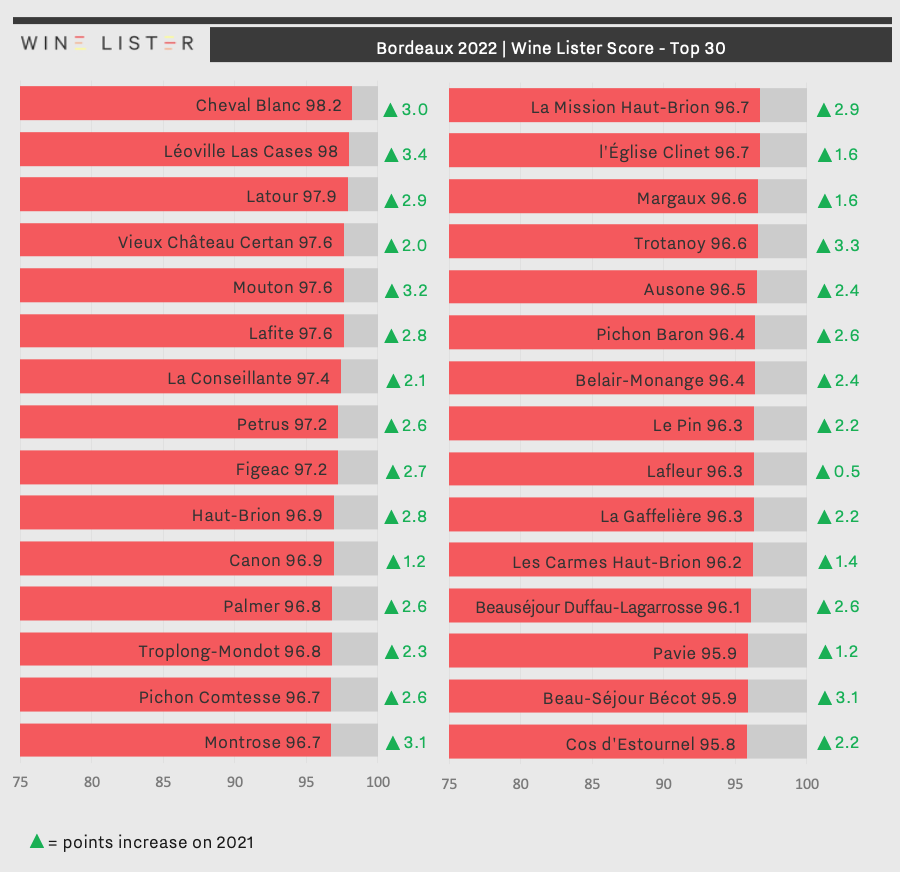
The 30 wines with the highest WL scores, including their points increase versus 2021
Reflecting trade and press sentiment regarding the exceptional quality of the 2022s, wines across the board have generally seen their WL scores increase on last year, and in some cases, significantly. This year, 64 wines achieve WL scores of 95 and over, more than double the number in 2021 (29). While the estates that made up our top 30 last year had an average score of 95.2, this year’s top 30 average 96.8 points.
A glaring observation: only red wines have scored above 96 in 2022 – the vintage having been kinder to Merlots and Cabernets than to their white counterparts, which struggled to maintain acidity in the heat. Only six whites – predominantly sweet wines from Sauternes and Barsac – scored just outside the examined range, with WL scores of around 95. These include – in descending order – Climens, Suduiraut, Doisy-Daëne L’Extravagant de Doisy (last year’s top-scoring wine, with 97 points in 2021), Rayne-Vigneau, La Mission Haut-Brion Blanc (the only dry white), and Fargues.
Turning to reds, Cheval Blanc stands at the top of the podium (up 3 points on 2021), followed by Léoville Las Cases (up 3.4 points), Latour (up 2.9 points), Vieux Château Certan (up 2 points), Mouton-Rothschild (up 3.2 points), and Lafite Rothschild (up 2 points), which all boast rounded scores of 98. They are closely tailed by La Conseillante (up 2.1 points), Petrus (up 2.7 points), and Figeac (up 2.6 points), amongst others.
The biggest climbers in the top 30 this year were Léoville Las Cases, with a WL score increase of 3.4 since the 2021, followed by Trotanoy with 3.3, Mouton-Rothschild with 3.2, La Mission Haut-Brion and Beau-Séjour Bécot with 3.1 points. On average, these 30 estates saw an increase of 2.4 points compared to 2021.
Right Bank estates take up the majority of places in this year’s top-30 list (56% compared to 45% in 2021). This is mainly thanks to 10 Saint-Émilion properties and their limestone terroirs featuring in the top 30 – exactly one third – versus 24% last year, whereas Pomerol’s representation is similar year-on-year (23% versus 21%). Other appellations featuring ore strongly in the top 30 are Pauillac (17% up from 14%), and Margaux and Saint-Estèphe (both 7% up from 3%), while Pessac-Léognan and Saint-Julien have seen their listings reduce (10% versus 17%; 5% versus 7%, respectively).
Owner and winemaker of her iconic family estate in Condrieu: “A wine is like its maker”.
The 15th in Le Figaro Vin’s series finds us in the northern part of the Rhône Valley where Christine Vernay, #36, has made her distinctive mark in the 25 years since she took over from her father, Georges Vernay.

From its home in Condrieu, Domaine Georges Vernay’s 24 hectares of vines, mainly comprised of Syrah and Viognier, extend over steep, precipitous terroirs. Georges Vernay began to develop the estate in 1953, starting out with 1.5 hectares of vines classified as AOC Condrieu Coteau de Vernon. A passionate defender of the appellation, he played a major part in its preservation.
As the third-generation owner of the family property, Christine Vernay, joined in 2020 by her daughter Emma Amsellem, maintains the family’s knowledge and expertise. Today they cultivate 10 hectares of vines classified as AOC Condrieu, including three hectares of old vines which produce the prestigious Le Coteau de Vernon and Les Chaillées de l’Enfer, wines which epitomise the Viognier grape variety in Condrieu. They also grow six hectares of vines classified as Côte-Rôtie, two hectares as Saint-Joseph, and six hectares as IGP Syrah and Viognier.
Le Figaro Vin: How does it feel to be crowned a winemaking champion?
Christine Vernay: A champion? I have never thought about it in those terms. It surprises me, but I am delighted by it.
Have you been training for long?
It has been a real marathon…nearly 30 years now.
Who is your mentor?
There have been quite a few. In the first place my family, then numerous encounters in the world of wine with men and women who have inspired me.
Is wine a team sport?
Of course. How could anyone think otherwise. Wine starts its life on the vine and our hillsides require so much attention that you need a strong team to manage successfully. Everyone plays their part. When the grapes reach the cellar I have a smaller team around me, it’s more intimate, I work more on my own, and I engage in a real one-to-one conversation with my wines.
What is the key to making a good wine? The terroir or the winemaker?
Without question, the terroir. For me the terroir is a wonderful confluence of place, vine, and winemaker. You then have the freedom of interpretation to make a great wine.
To what do you owe your success?
For a winemaker the definition of success changes every year. My awareness of its transient nature stimulates and strengthens me. I believe that desire, pleasure, doubts, convictions, and, above all, commitment to inherited values are all key to progress and success.
Is your family proud of you?
I hope so!
Who is your biggest supporter?
I don’t have any.
Your favourite colour?
Red – the red of Maison Rouge.
Your favourite wine?
My heart swings between Coteau de Vernon and Maison Rouge.
Your favourite vintage?
1997, my first vintage.
If your wine was a person, who would it be?
It would be me. I often find that a wine is like its maker.
What are the best circumstances in which to taste your wine?
My favourite circumstances for tasting it are when you are tuned in to the sensations that it can bring you.
Have you ever thought about chemically enhancing yourself, or your wine?
Our reciprocal energies are enough in themselves.
For what price would you be prepared to sell your estate?
I am not prepared to sell it.
Who is your strongest competition?
Nature, which you have to contend with all the time.
Which competition do you dread the most?
At the beginning of the harvest, when you are walking through the vines, tasting the grapes, keeping a watchful eye on the earth and the sky, and deciding when to press start, you experience a powerful adrenaline rush. I dread it, but I love it.
What is your greatest trophy?
The smile and serenity of my father watching me be a winemaker.
What has been your most innovative strategy in the vineyard and in the cellar?
Commitment to a way of working that respects the environment and having the flexibility to be as close as possible to the vines, the grapes, and the wine, contingent on the demands of nature, the vintage, the weather…
Who would be your ideal successor on the podium?
My daughter!
Tasting for Le Figaro, Ella Lister and her colleague, Béatrice Delamotte, spent a fortnight in Bordeaux tasting 600 wines en primeur from the extraordinary 2022 vintage – extraordinary in terms of its textures, its accessibility, and its unexpected freshness in such a dry, hot year – that has produced wines with technically high levels of tannin which somehow just melt into the background. We tasted many of the wines together, and sometimes two or three times in order to be able to judge each sample as faithfully as possible.
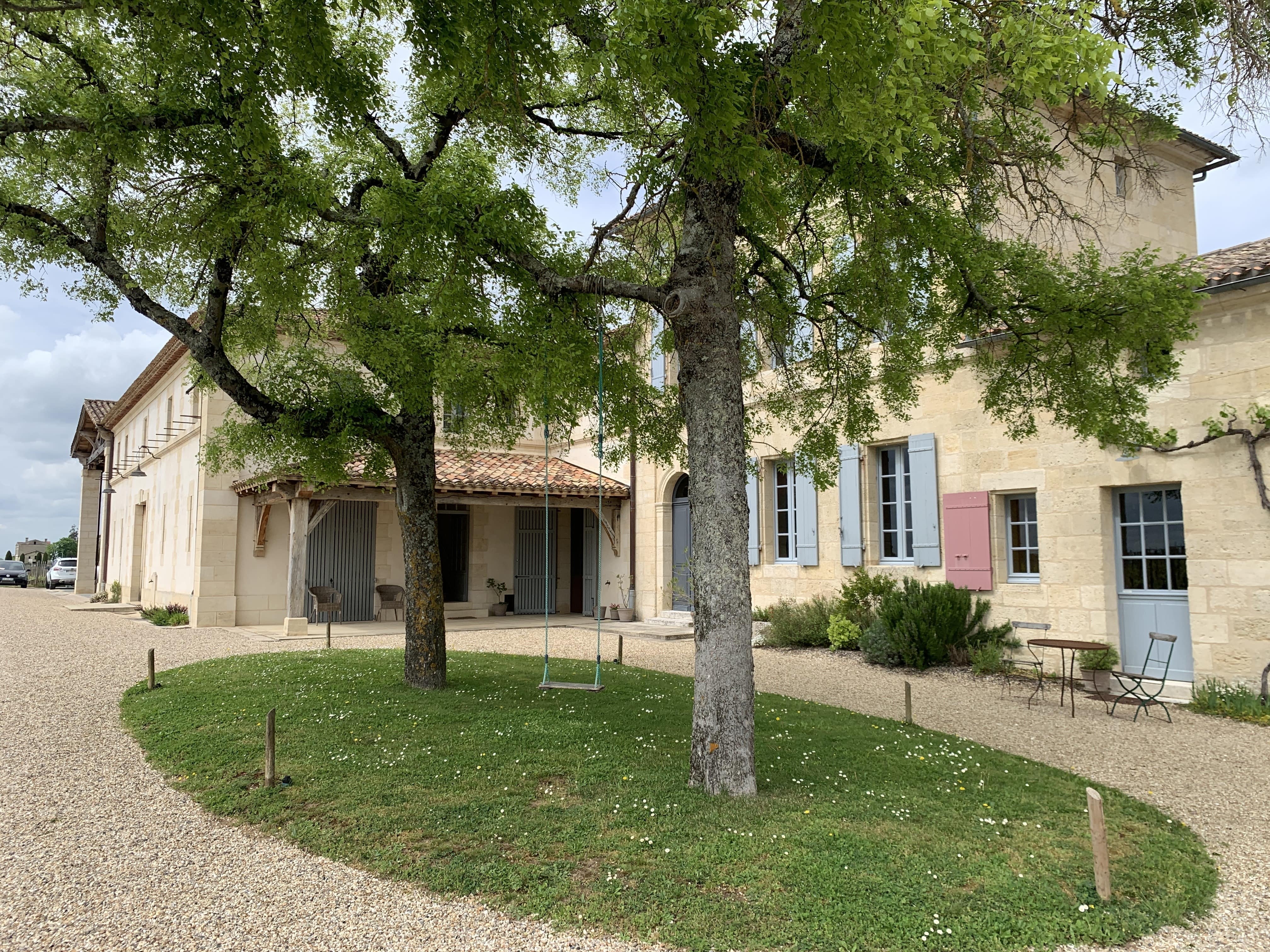
Château Lafleur
The Vintage
After a difficult 2021 vintage, 2022 is without doubt a contender for the vintage of the century – so far –, showing signs at this early stage of outdoing the magnificent triptych 2018, 2019, and 2020, and will perhaps go down in history as the 1982 has done. After almost 20 years as Technical Director at Château Cos d’Estournel, Dominique Arangoïts expressed this in slightly different words, suggesting that 2022 “might be the wine of my life”.
And the most extraordinary thing is that nobody expected it. The vines were subjected to some of the driest conditions on record, as well as above-average temperatures. However, there were no extreme heatwaves (as in 2003), and night-time temperatures remained relatively cool, dropping on average to around 15°c. The vines grew accustomed to the hot, dry conditions early in the growing season, which meant they adapted their consumption and their canopy growth in order to cope with what little water they had, making do with reserves amassed during a rainy 2021, then a top-up in June, and then surviving 50 dry days until mid-August. Refuting any comparison with 2003, Nicolas Audebert, Managing Director of Châteaux Canon and Rauzan-Ségla, uses the analogy of an office worker being cooped up until August, and getting sunburnt going out into the bright sun for the first time, whereas 2022 was a more gradual acclimatisation for the vines.
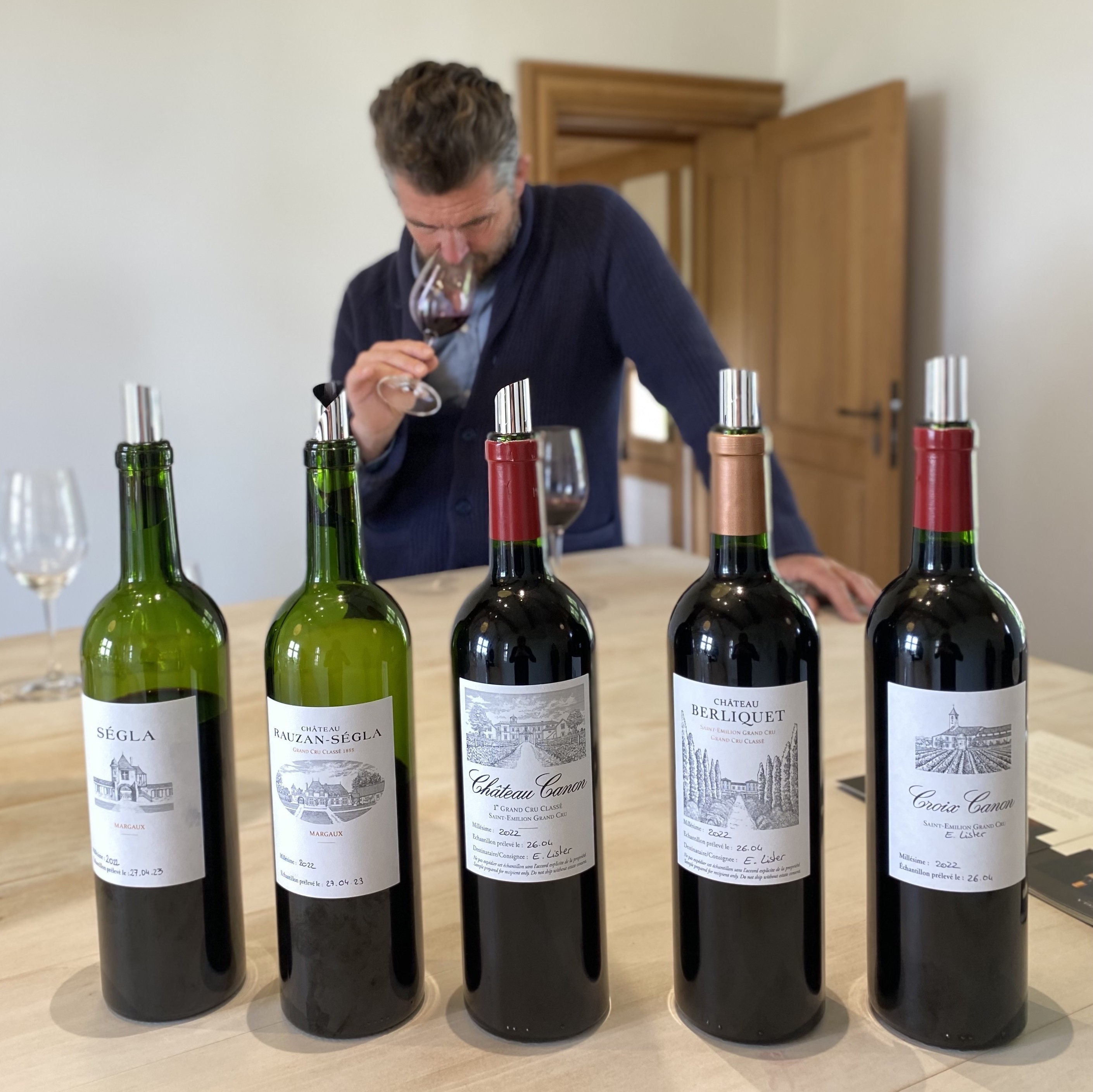
Nicolas Audebert, Managing Director of Châteaux Canon, Rauzan-Ségla and Berliquet
One of the buzzwords of the vintage, cited over and over again in our conversations with owners, winemakers, and consultants in the region was ‘resilience’. “ The vines, the soils, and the people were resilient,” said Omri Ram, Cellar Master and Head of Research and Development at Château Lafleur. That the vines survived the prolonged drought with relative ease and produced such stunning results was a shock to everyone, with many vignerons telling us they were more stressed than vines. Mathieu Cuvelier, owner of Clos Fourtet, found the experience quite stressful, even though “there was little that needed doing – no green harvesting, no de-leafing, very light vinification”. Pierre-Olivier Clouet, Technical Director at Château Cheval Blanc concurs, recounting “the vineyard made the wine all by itself”.
By early August the pips were already brown, i.e. phenolically ripe, “We had never witnessed that before” explains Frédéric Faye, the Managing Director of Château Figeac. However, the extreme weather conditions did leave room for mistakes for those were not attentive enough to picking dates or not gentle enough with their extraction. So 2022 wasn’t a vintage of homogenous quality, but overall, it was a pleasure to taste, and much easier for professional tasters than 2021, where we battled with oak, firm tannins, and biting acidity to assess potential quality. This year, the majority of wines are already so expressive and caressing as to be almost ready to drink, while possessing all the necessary attributes to age well.
“The wonderful thing this year is that every grape variety did rather well,” exclaimed Christian Seely, Managing Director of AXA Millésimes, parent company of Château Pichon Baron, explaining that while above all it’s a great Cabernet year, “the Merlots are as beautiful as they’ve ever been”. Many wines in 2022 featured a higher proportion of Merlot than usual, as the Cabernet berries were small and yielded less juice. In fact, 2022 sparked lots of positivity around Merlot, with Stéphanie de Boüard-Rivoal, co-owner of Château Angélus, commenting that the vintage shows “Merlot can exist long into the future”, contrary to recent concerns about its capacity to stand up to a warmer, drier climate.
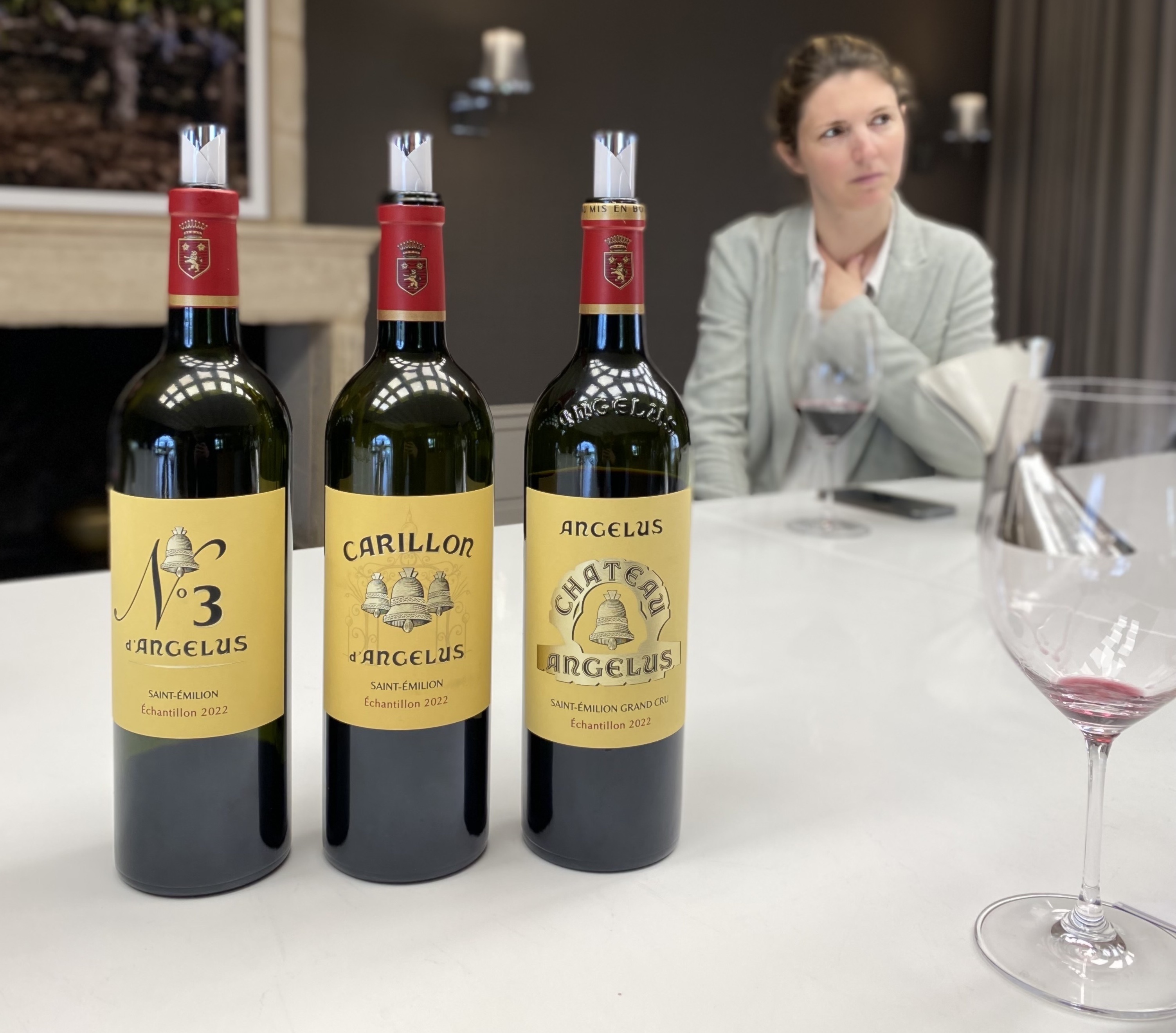
Stéphanie de Boüard-Rivoal, co-owner and CEO of Château Angélus
The Wine
The red wines – the unquestionable winners in 2022 – are dense and concentrated, yet fresh, fruity, floral, and sappy. Above all, the best wines display a range of magical textures from silk and cashmere to duckling feathers, and a common and delightful thread through many of the wines is a vegetal florality reminiscent of the sap of fresh cut flowers. The least successful wines present harsh tannins. The best ones, on the other hand, are so fresh and tender that you would never know they came from such a dry, hot vintage, nor guess the resulting high IPTs and low pHs.
The dry whites, however, found it harder to contend with the vintage, and the low acidity levels can be more apparent than in the red. There are, nonetheless, a handful of successful whites worth looking out for, which possess the best and subtlest exotic notes, a finesse and softness that counteract the richness of the vintage. The sweet wines are very good, if not incredible, rich with delicious botrytis flavours and very high residual sugar levels.
The 2022 vintage is not one with an obviously overperforming appellation or subregion. Left and Right Bank made astonishing wines, and we have been inspired by our tastings to bestow an unprecedented number of potential 100-point scores to the wines. You can discover all eight possibly “perfect” wines, and hundreds more, on the Wine Lister and Figaro Vin websites now.











